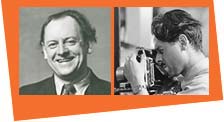Home (The Foundation) - Artist biographies - Ernst Schwitters
Page 1 |
2
1940
The Germans invade Norway on 9 April. Kurt, Ernst and Esther flee Oslo, traveling first to Åndalsnes. They try in vain to reach Molde/Hjertøya, then travel to Ålesund, where they are interned for several weeks. A fishing boat eventually takes them to northern Norway. They are confined again in Sortland, Kabelvåg, and Harstad but manage to find their way to Tromsø, from where they depart for Scotland on the ice-breaker Fridtjof Nansen on 8 June, arriving there on 18 June. Kurt and Ernst are interned again and confined at several different camps, including Camp Hutchinson in Douglas on the Isle of Man. Esther Guldahl Schwitters is also placed in confinement and separated from her husband, but is soon released. Ernst Schwitters remains in internment until 14 July 1941.
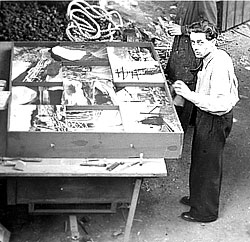 1941
1941
Following his release, Ernst is hired by the Anglo-American photography firm Polyfoto Ltd. In the autumn, he is commissioned by the Norwegian government-in-exile to organize a major Norwegian exhibition. The 2,500 negatives he took out of Norway during his escape make up 60 per cent of the exhibit.
1942
The Norwegian exhibition is opened at Harrods’ department store by King Haakon VII in February and is a great success. Ernst Schwitters is offered a permanent position in the Propaganda Ministry of the Norwegian exile government. By war’s end, he has advanced to the position of exhibitions director. He provides his negatives for use by the government authorities free of charge. Applies for Norwegian citizenship in March, but the application is denied.
Schwitters submits numerous photographs for the Norwegian exile magazine Fram, where his photographs are featured in over half of all articles and back cover pages. Publication of the magazine is discontinued after the war.
Ernst Schwitters is admitted to membership in the Royal Photographic Society. Ernst, his colleague Gert Strinfberg and Kurt Schwitters move to the London suburb of Barnes.
Separates from Esther Guldahl.
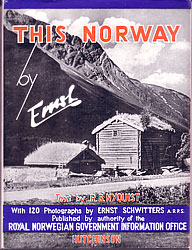 1943
1943
Ernst Schwitters is named an Associate of the Royal Photographic Society (ARPS) in recognition of his photo album entitled One Day in Norway on 10 May. His work is accepted for presentation at two major photo exhibitions in London. He does a number of nude/studio photographs, including The Seventh Veil and In Passing.
Introduced by his father to Lola “Eve” Mehrgut, a Jewish immigrant from Germany. His second application for Norwegian citizenship is denied.
In the autumn he organizes an attempt to smuggle his remaining negatives out of Norway (numbering around 5,000), but the aircraft that is to bring them from Sweden disappears over the North Sea and the negatives are lost.
1944
Ernst and Esther Guldahl are divorced on 27 January.
This Norway, a book featuring text by Roi B. Nyquist and photographs by Ernst Schwitters, is published on 17 May (Norway’s national holiday). All 5,000 copies are sold within a few months. He spends the summer holidays in the Lake District in northern England and produces landscapes and nudes. He takes part in twenty-three exhibitions and three competitions and exhibits his first colour photographs (Kodachrome). Schwitters now signs his photographs with “Ernst”.
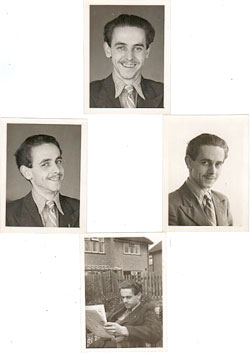 He
presents a non-photographic work of art for the last time at the "Inter
Allied Exhibition" in London.
He
presents a non-photographic work of art for the last time at the "Inter
Allied Exhibition" in London.
Helma Schwitters dies of cancer in Hanover on 29 October.
1945
Participates in twenty-seven group and two solo exhibitions (in Liverpool and Port Talbot). The war ends in Europe on 8 May. Ernst Schwitters departs for Norway on 16 June.
He puts the apartment in Lysaker in order, although it is in relatively good condition thanks to landlady Bertha Jensen (“Aunt Jensen”). She was able to hide a number of things before the apartment was seized by the German occupation authorities. Works as exhibition director for the NTB news agency and as a freelance photographer for various publications, including the journal Aktuell. He gains recognition as a photographer in Norway through his documentation of the Quisling trial that summer. Ernst Schwitters and Lola “Eve” Mehrgut marry in London on 16 November. Of the Mehrgut family persecuted as Jews, Lola's brother Kurt Georg (born 1914) died in Mauthausen concentration camp in 1941; her father Wolf Willi (born 1883) was killed in Bergen-Belsen concentration camp in 1945. Her mother Gertrud and sister Eliese Felicitas emigrated to the USA. The best man is his father Kurt Schwitters, who now lives in Ambleside. The couple moves into the apartment in Lysaker. Schwitters is granted Norwegian citizenship in December.
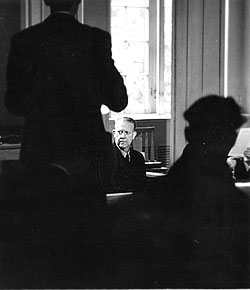 1946
1946
Becomes a member of the Oslo Kamera Klubb (OKK) and participates in competitions and exhibitions. He travels to Møre with the Committee for Reconstruction on assignment as an NTB photographer in Februaryy and to Trøndelag in the late spring.
Many of his best-known studio photographs are done in 1946, among them Indian Dance. Delivers his first lecture at the Oslo Kamera Klubb.
1947
Birth of his son Bengt on 9 June.
Schwitters receives major commissions for industrial photography in Holmestrand and Høyanger.
His considerable photographic activity includes participation in thirty-six exhibitions and four competitions.
1948
Kurt Schwitters dies in Kendal in the Lake District on 8 Januaryy. Ernst is his primary heir, through the majority of the paintings completed in England are bequeathed to Edith Thomas, Kurt’s companion during his last years.
Ernst resigns his position at NTB to devote himself to freelance photography. Most of his work involves industrial photography and the documentation of historical cultural objects. He also produces photographs for calendars and books about Norway. This is his busiest year, with forty-three exhibition participations and five competitions.
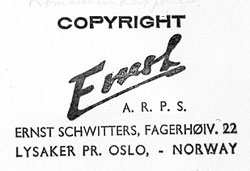 1949
1949
Schwitters visits Germany and Hanover for the first time since 1936. Initiates a debate on composition and photography in Kamera, the journal of the Norwegian Photo Club, with his article entitled “Er komposisjon et absolutt begrep?” (Is Composition an Absolute Concept?).
1950
Delivers his first lectures at the Folkeakademiet in Norway and to photography clubs outside Oslo.
1951
Awarded the gold medal by the Norsk Selskap for Fotografi (Norwegian Photography Society, NSfF) after winning the national competition. He works as a photo editor for the books Vår gamle bondekultur (Our Old Peasant Culture) and Olympic Winter Sports in Norway.
1952
Extensive lecture tours in Norway; major industrial commission for Saugbruksforeningen, in Halden.
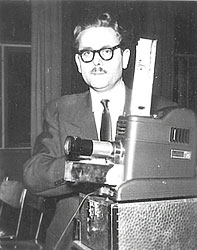 1953
1953
Schwitters is admitted to membership in the Norske Reklamefotografers Landsforening (National Association of Norwegian Advertising Photographers).
1954
Presents lectures to readers societies and photo clubs around Sweden. He purchases a Hasselblad, which eventually becomes his favourite camera.
1955
Schwitters is the first photographer to receive a second gold medal from the NfFS.
1956
Ernst Schwitters takes part in "Foto i Fokus", a major exhibition of commercial photographs, in Oslo. He is named an honorary member of NfFS.
The first significant post-war Kurt Schwitters exhibition is presented at the Kestner-Gesellschaft in Hanover. Through his publications and lectures, Ernst Schwitters has gained recognition as an expert on Kurt Schwitters. He begins inventorying his father’s work.
1957
Schwitters is honoured as an “Excellence de la Fédération Internationale de l’Art Photographique” (EFIAP).
1959
Builds a new studio, darkroom and office at his home in Lysaker.
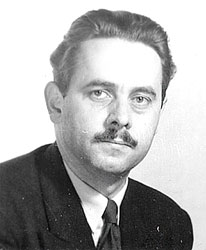 1961
1961
Awarded the gold medal and granted honorary membership by the Oslo Kamera Klubb. Schwitters chairs the jury for the major international anniversary exhibition.
1962
Schwitters serves on the jury for the colour photography competition “En Manifestation i Färg” organized by the Nordiska Fotograf Förbundets (Nordic Photographers’ Society). Becomes the first recipient of the Award of Honour presented by the magazine Kamera for his outstanding contribution to Norwegian photography.
1963
He begins working with the Marlborough Fine Art Gallery in London, which assumes responsibility for representing Kurt Schwitters internationally.
1967
Ernst sells his father’s art collection and cuts back on his work as a professional photographer. During his many travels he now takes mainly colour photos.
1970s Jahre
He stops working as a professional photographer. He builds a house on the island of Tenerife, where he spends several months every year.
1977
Schwitters is diagnosed with cancer of the larynx. Surgery is successful.
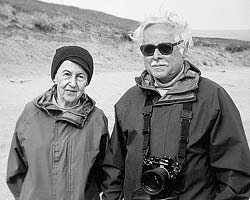 1980
1980
Begins to build a new art collection and travels extensively throughout the 1980s, journeying to the Artic and Antarctica, America, Australia, Oceania, and Asia. Tens of thousands of slides document his travels.
1989
The solo exhibition entitled “Ernst Schwitters - Pictorial Photography” is presented at the Galerie Gmurzynska in Cologne (also shown in Bergen, Norway, in 1991).
1993
Ernst donates to the Sprengel Museum Hannover the records documenting Kurt Schwitters’s oeuvre, which serve as the foundation for the later catalogue raisonné. Schwitters suffers a stroke in September and is unable to speak for the rest of his life.
1996
Ernst Schwitters dies at a nursing home in Oslo on 17 December
1998
In accordance with his wishes, his remains are interred at the family grave at the Engesohder cemetery, in Hanover.
Page 1 | 2
© Kurt and Ernst Schwitters Foundation
1940
The Germans invade Norway on 9 April. Kurt, Ernst and Esther flee Oslo, traveling first to Åndalsnes. They try in vain to reach Molde/Hjertøya, then travel to Ålesund, where they are interned for several weeks. A fishing boat eventually takes them to northern Norway. They are confined again in Sortland, Kabelvåg, and Harstad but manage to find their way to Tromsø, from where they depart for Scotland on the ice-breaker Fridtjof Nansen on 8 June, arriving there on 18 June. Kurt and Ernst are interned again and confined at several different camps, including Camp Hutchinson in Douglas on the Isle of Man. Esther Guldahl Schwitters is also placed in confinement and separated from her husband, but is soon released. Ernst Schwitters remains in internment until 14 July 1941.
 1941
1941 Following his release, Ernst is hired by the Anglo-American photography firm Polyfoto Ltd. In the autumn, he is commissioned by the Norwegian government-in-exile to organize a major Norwegian exhibition. The 2,500 negatives he took out of Norway during his escape make up 60 per cent of the exhibit.
1942
The Norwegian exhibition is opened at Harrods’ department store by King Haakon VII in February and is a great success. Ernst Schwitters is offered a permanent position in the Propaganda Ministry of the Norwegian exile government. By war’s end, he has advanced to the position of exhibitions director. He provides his negatives for use by the government authorities free of charge. Applies for Norwegian citizenship in March, but the application is denied.
Schwitters submits numerous photographs for the Norwegian exile magazine Fram, where his photographs are featured in over half of all articles and back cover pages. Publication of the magazine is discontinued after the war.
Ernst Schwitters is admitted to membership in the Royal Photographic Society. Ernst, his colleague Gert Strinfberg and Kurt Schwitters move to the London suburb of Barnes.
Separates from Esther Guldahl.
 1943
1943 Ernst Schwitters is named an Associate of the Royal Photographic Society (ARPS) in recognition of his photo album entitled One Day in Norway on 10 May. His work is accepted for presentation at two major photo exhibitions in London. He does a number of nude/studio photographs, including The Seventh Veil and In Passing.
Introduced by his father to Lola “Eve” Mehrgut, a Jewish immigrant from Germany. His second application for Norwegian citizenship is denied.
In the autumn he organizes an attempt to smuggle his remaining negatives out of Norway (numbering around 5,000), but the aircraft that is to bring them from Sweden disappears over the North Sea and the negatives are lost.
1944
Ernst and Esther Guldahl are divorced on 27 January.
This Norway, a book featuring text by Roi B. Nyquist and photographs by Ernst Schwitters, is published on 17 May (Norway’s national holiday). All 5,000 copies are sold within a few months. He spends the summer holidays in the Lake District in northern England and produces landscapes and nudes. He takes part in twenty-three exhibitions and three competitions and exhibits his first colour photographs (Kodachrome). Schwitters now signs his photographs with “Ernst”.
 He
presents a non-photographic work of art for the last time at the "Inter
Allied Exhibition" in London.
He
presents a non-photographic work of art for the last time at the "Inter
Allied Exhibition" in London. Helma Schwitters dies of cancer in Hanover on 29 October.
1945
Participates in twenty-seven group and two solo exhibitions (in Liverpool and Port Talbot). The war ends in Europe on 8 May. Ernst Schwitters departs for Norway on 16 June.
He puts the apartment in Lysaker in order, although it is in relatively good condition thanks to landlady Bertha Jensen (“Aunt Jensen”). She was able to hide a number of things before the apartment was seized by the German occupation authorities. Works as exhibition director for the NTB news agency and as a freelance photographer for various publications, including the journal Aktuell. He gains recognition as a photographer in Norway through his documentation of the Quisling trial that summer. Ernst Schwitters and Lola “Eve” Mehrgut marry in London on 16 November. Of the Mehrgut family persecuted as Jews, Lola's brother Kurt Georg (born 1914) died in Mauthausen concentration camp in 1941; her father Wolf Willi (born 1883) was killed in Bergen-Belsen concentration camp in 1945. Her mother Gertrud and sister Eliese Felicitas emigrated to the USA. The best man is his father Kurt Schwitters, who now lives in Ambleside. The couple moves into the apartment in Lysaker. Schwitters is granted Norwegian citizenship in December.
 1946
1946Becomes a member of the Oslo Kamera Klubb (OKK) and participates in competitions and exhibitions. He travels to Møre with the Committee for Reconstruction on assignment as an NTB photographer in Februaryy and to Trøndelag in the late spring.
Many of his best-known studio photographs are done in 1946, among them Indian Dance. Delivers his first lecture at the Oslo Kamera Klubb.
1947
Birth of his son Bengt on 9 June.
Schwitters receives major commissions for industrial photography in Holmestrand and Høyanger.
His considerable photographic activity includes participation in thirty-six exhibitions and four competitions.
1948
Kurt Schwitters dies in Kendal in the Lake District on 8 Januaryy. Ernst is his primary heir, through the majority of the paintings completed in England are bequeathed to Edith Thomas, Kurt’s companion during his last years.
Ernst resigns his position at NTB to devote himself to freelance photography. Most of his work involves industrial photography and the documentation of historical cultural objects. He also produces photographs for calendars and books about Norway. This is his busiest year, with forty-three exhibition participations and five competitions.
 1949
1949 Schwitters visits Germany and Hanover for the first time since 1936. Initiates a debate on composition and photography in Kamera, the journal of the Norwegian Photo Club, with his article entitled “Er komposisjon et absolutt begrep?” (Is Composition an Absolute Concept?).
1950
Delivers his first lectures at the Folkeakademiet in Norway and to photography clubs outside Oslo.
1951
Awarded the gold medal by the Norsk Selskap for Fotografi (Norwegian Photography Society, NSfF) after winning the national competition. He works as a photo editor for the books Vår gamle bondekultur (Our Old Peasant Culture) and Olympic Winter Sports in Norway.
1952
Extensive lecture tours in Norway; major industrial commission for Saugbruksforeningen, in Halden.
 1953
1953 Schwitters is admitted to membership in the Norske Reklamefotografers Landsforening (National Association of Norwegian Advertising Photographers).
1954
Presents lectures to readers societies and photo clubs around Sweden. He purchases a Hasselblad, which eventually becomes his favourite camera.
1955
Schwitters is the first photographer to receive a second gold medal from the NfFS.
1956
Ernst Schwitters takes part in "Foto i Fokus", a major exhibition of commercial photographs, in Oslo. He is named an honorary member of NfFS.
The first significant post-war Kurt Schwitters exhibition is presented at the Kestner-Gesellschaft in Hanover. Through his publications and lectures, Ernst Schwitters has gained recognition as an expert on Kurt Schwitters. He begins inventorying his father’s work.
1957
Schwitters is honoured as an “Excellence de la Fédération Internationale de l’Art Photographique” (EFIAP).
1959
Builds a new studio, darkroom and office at his home in Lysaker.
 1961
1961 Awarded the gold medal and granted honorary membership by the Oslo Kamera Klubb. Schwitters chairs the jury for the major international anniversary exhibition.
1962
Schwitters serves on the jury for the colour photography competition “En Manifestation i Färg” organized by the Nordiska Fotograf Förbundets (Nordic Photographers’ Society). Becomes the first recipient of the Award of Honour presented by the magazine Kamera for his outstanding contribution to Norwegian photography.
1963
He begins working with the Marlborough Fine Art Gallery in London, which assumes responsibility for representing Kurt Schwitters internationally.
1967
Ernst sells his father’s art collection and cuts back on his work as a professional photographer. During his many travels he now takes mainly colour photos.
1970s Jahre
He stops working as a professional photographer. He builds a house on the island of Tenerife, where he spends several months every year.
1977
Schwitters is diagnosed with cancer of the larynx. Surgery is successful.
 1980
1980 Begins to build a new art collection and travels extensively throughout the 1980s, journeying to the Artic and Antarctica, America, Australia, Oceania, and Asia. Tens of thousands of slides document his travels.
1989
The solo exhibition entitled “Ernst Schwitters - Pictorial Photography” is presented at the Galerie Gmurzynska in Cologne (also shown in Bergen, Norway, in 1991).
1993
Ernst donates to the Sprengel Museum Hannover the records documenting Kurt Schwitters’s oeuvre, which serve as the foundation for the later catalogue raisonné. Schwitters suffers a stroke in September and is unable to speak for the rest of his life.
1996
Ernst Schwitters dies at a nursing home in Oslo on 17 December
1998
In accordance with his wishes, his remains are interred at the family grave at the Engesohder cemetery, in Hanover.
Page 1 | 2
© Kurt and Ernst Schwitters Foundation

